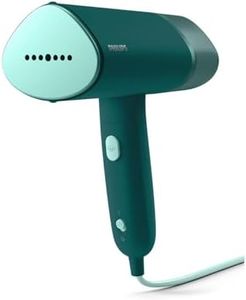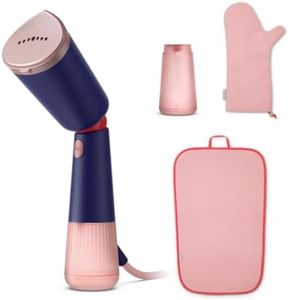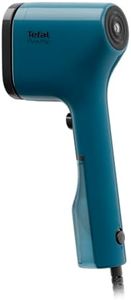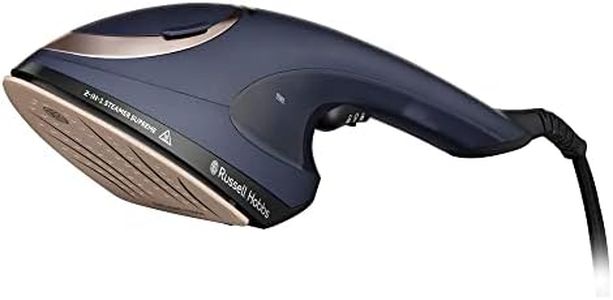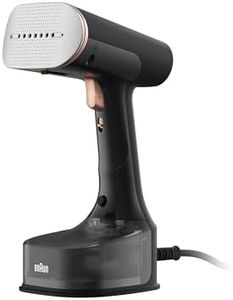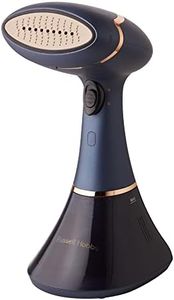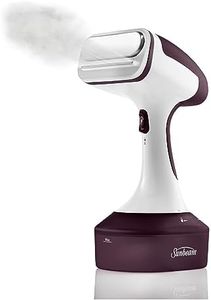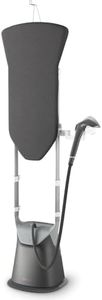We Use CookiesWe use cookies to enhance the security, performance,
functionality and for analytical and promotional activities. By continuing to browse this site you
are agreeing to our privacy policy
10 Best Garment Steamers
From leading brands and best sellers available on the web.Buying Guide for the Best Garment Steamers
Choosing the right garment steamer can make your clothing care much easier and even prolong the life of your fabrics. Unlike irons, steamers offer a quick way to remove wrinkles and refresh clothes safely, making them popular with busy people and those with lots of delicate or varied fabrics. When picking a garment steamer, focus on your clothing needs, how often you’ll use the steamer, and where you plan to use it. Each key feature plays a role in convenience, performance, or safety, so understanding them helps you find the best fit for your wardrobe and routine.Water Tank CapacityWater tank capacity refers to how much water the steamer’s reservoir can hold at one time. This is important because a larger tank lets you steam more clothes in one go without stopping to refill. Tank capacities often range from small, handheld models with about 100-200 ml to larger, standing steamers with over a liter. If you usually do quick touch-ups or travel, a small tank is lighter and more portable. For regular, heavy steaming or families, a big tank will save time and effort.
Steam OutputSteam output measures how much steam is released, typically written as grams per minute. This is crucial because higher output tackles wrinkles faster and is more effective on heavier fabrics. Lower steam output is gentler and suitable for lighter or delicate materials. If you have mostly lightweight garments, a gentle output works well. For thicker clothing, curtains, or upholstery, go for higher steam output for powerful results.
Heating TimeHeating time means how quickly the steamer is ready to use after you turn it on. Some heat up in as little as 30 seconds, while others may take a few minutes. Faster heating is valuable when you’re short on time or steaming in the mornings before work. If you don’t mind waiting or do longer sessions, a slightly slower start might not make a difference to you.
Size and PortabilitySize and portability refers to how big the steamer is and how easy it is to move or store. Handheld models are compact and convenient for travel or quick jobs, while upright steamers are bigger but offer more powerful, continuous steaming. Consider whether you need something easy to pack in a suitcase, or if it will mostly stay at home in your laundry area. If storage space is limited, a smaller model will be more practical.
Steam Head DesignThe steam head is the part that releases steam onto your fabric. Some have broad surfaces for faster work on big items, while other designs have smaller, more precise tips for focused steaming. Certain steam heads are made of metal, which glides smoothly, while plastic ones may be lighter. Your garment types should guide your choice—large surfaces are best for dresses and curtains, while a smaller head is ideal for details and tight areas like shirt collars.
Continuous Steaming TimeContinuous steaming time indicates how long a steamer can operate without stopping. It’s directly tied to the tank size and steam output. Shorter times are fine if you only steam a couple of garments at a time. If you plan to steam lots at once—like doing laundry day chores or refreshing curtains—look for a model that can work for at least 15–30 minutes without a break.
Safety FeaturesSafety features can include automatic shut-off, anti-drip technology, and heat-resistant handles. These matter because they prevent accidents, especially if you have kids or may get distracted easily. Always look for a steamer with a good safety record if you’ll be using it frequently or in a household with others, to keep both you and your home safe.
